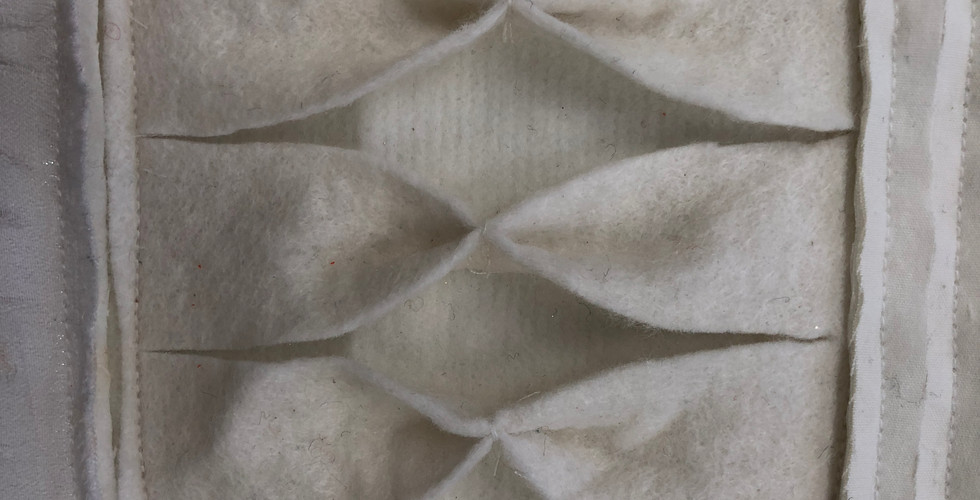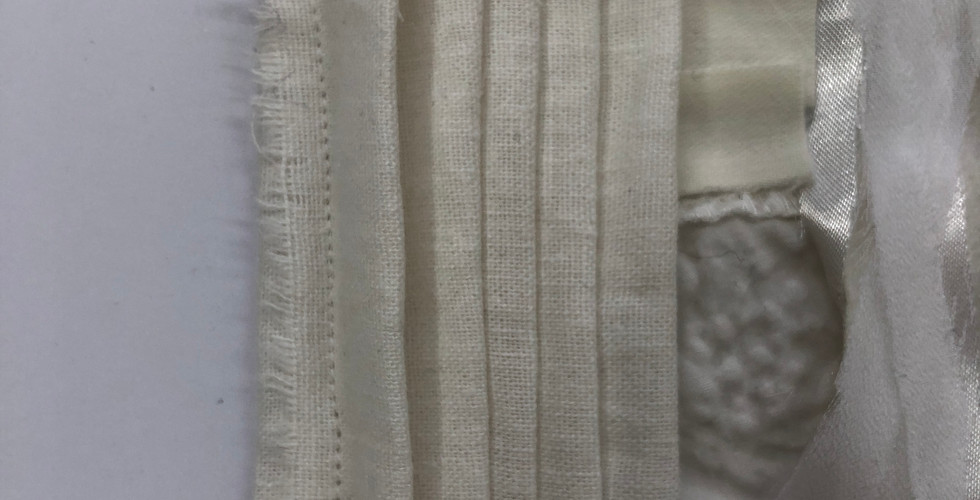Textiles
- Jussy saltiga

- Oct 30, 2018
- 7 min read
Updated: Dec 6, 2018
-Drawing with stitch is the first textile technique we had done as an introduction to textiles and for us as a class to get used the machines. I have previous experience with sewing machines before as I had taken textiles as one of my GCSE courses, drawing with stitch helped me to remind myself of how to use a sewing machine again.
Whilst researching drawing with stitch I came across an artist named Rosie James, she uses sewing as a tool for drawing. Since I'm interested in fashion, I found this piece in which is named 'catwalk flowers', I loved the outlines the figures made and how they are faceless. Also I loved the silhouettes in the background which is appliquéd.

Elsa Hansen Oldham is an embroidery textile artists, she focuses on pop culture as a basic of her art. I appreciate how she bases the subject of her art around modern day people and things, it shows that she is aware of relevant subject matter which then creates attention to her work.

https://www.artsy.net/article/artsy-editorial-11-artists-embroidery-radical-ways
-Applique is the form attaching pieces of fabric onto a large piece. I've looked at a haute couture fashion designer named Teuta Matoshi Duriqi. She has beautiful delicate dresses, which involves alot of appliqued lace, fabric flowers and beads. What caught my attention was the attention to detail, each flower and bead is sewed on by hand; which gives a 3D effect instead of being sewed on a machine.

-Reverse Applique is self explanatory, how it works is by having the fabric underneath and the layer on top is cut to expose the one underneath. The edges can be left raw or sewn. James Fox is an artist who uses reverse applique a lot in his work as well as other textile techniques.
His work is very cooperative with other techniques, this is something I love within his art. He uses a lot of patterns which juxtaposes each other and from a far creates a bigger picture.

-I really enjoyed working with Dissolvable fabric the most, I loved the laced effect it gave. To summarise, the fabric disappears once washed with water, so you are able to sew onto the fabric how you want to and when the fabric is gone you are left with the tracks of thread that is sewn on. There are endless possibilities of outcomes you can create with this, I love how creative you can make things out of thread.
The artist that gave me my inspiration is called Anne Honeyman, she makes beautiful flowers from dissolvable fabric.

I like how the curl in and have actual shape, rather than 2D. I am impressed on how she manages to make the flowers so delicate as working with dissolvable fabric can easily rip.
My samples:
My first sample of drawing with stitch was just experimenting and getting used to the machine.
The second one was a drawing I did as part of life drawing, I just did a normal running stitch. The last one was also a life drawing piece I did partly of. The third one I had inspiration from the textile artist Elsa Hansen Oldham however I did it on the sewing machine. I liked how drawing with stitch allows us to have freedom to draw loosely on the machine. The continuous drawing I did on the first one is an example of this.
Here I have done a mix of applique, drawing with stitch, dissolvable fabric and reverse applique. I got an image of a cat walk figure and drew it on top of the fabric, then I simply stitched on top, I also left the strays on the drawing just like Rosie James. To the right of the drawing I appliqued on the silhouette of the drawing with stitch, however I enlarged it and sewed it on with a zig zag stitch.
The second one I had repeated drawing on the figure and then appliqued the sliver dress on with the tule skirt bits on. I enjoyed doing this as it is like making my drawing come alive a bit.
The last one I used a thick, velvet sofa material to sew on top of with white stitch. This one is a reverse applique, I sewed the edges down with a zig zag stitch.
This reverse applique I had planned several layers underneath in which I have a different fabric poking out of the areas to represent shade and light. At first I stitched my initial design on all of the fabric. Then I cut out the first layer which is the white fabric to unravel the red satin fabric, underneath that I is a glittery white fabric which will represent the highlighted areas. The outer edges I have a dark red tule; lastly I have a plain dark red fabric to add for shade.
The butterfly is my first try at using dissolvable fabric, I used an emerald green thread as a basis of the butterfly. Then I subtlety added in pink and yellow to compliment the green. When added in water it ruined the shape of the butterfly.
From looking at the artist Anne Honeyman and the fashion designer Teuta Matoshi Duriqi, I really loved their work for the flowers and it got my head generating ideas for my project, by creating my own flowers and appliqueing it on the mesh fabric. That is what I have done as a sample and it had worked pretty well. I loved how the flowers dried and formed it's shape.
-Fabric manipulation is like wise to paper manipulation, in textile we were given ten pieces of white fabric to manipulate with. We were given the freedom to do anything with the fabric as long as we don't dye it. Alana Tyson is a famous artist known for fabric manipulation, she makes the scale of her art life size that drapes in the room. The type of fabric she uses has a sheen on it that reflects with light shining on it when is it ranched up. The feel I get from this is a wavy fantasy, as if it is like a dream.


I've made a board of my own little samples from fabric manipulation.
1) I started with stitching a satin fabric on to a plain cotton fabric and then cut even strips. After I went along and twisted each strip, whilst sewing the end of it to secure it. I like how the fabric shines from the effect of twisting the fabric. If I were to do it again Id iron on hemming tape to the satin fabric so when it is cut the fabric won't stray.
2) For the next one I layered a few different pieces of fabric together and sewed several straight lines across the fabric, after I cut in-between the lines. This method is called chenilling, the appearance looks better when it is put through the washer and dryer so it opens up the layers.
3) I used a felt material to make this manipulation. What I did was similar to the second one, however I stitched each side with just a normal running stitch, I also cut even strips along the space I had and then pinched the middle of each strip and sewed it down. This one is one of my favorites, the outcome looks like small rows of bows.
4) I also gathered three or two different fabrics to fringe, this one is my least favourite as it doesn't give me much of a reaction as the previous.
5) Here I used a heat gun and from a distance I moved the heat gun around the fabric. I loved the effect it gave off of bubbly and textured.
6) I had made a wavy, loopy manipulation by making the fabric bump up and sewing it down. I like the variation of size I got.
7) I folded up a basic cotton fabric into a fan and heat gunned the creases so it created pleats. If I were to do it again, I'd iron the folds down to get it clean and crisp.
8) This one is similar to number 6, however I had made fold overs instead.
9) This last one was inspired by Alana Tyson, I tried to recreate the ripples like she did. I bunched up the fabric and with a thread and needle I sewed through the ripples to keep them together. This was my least favourite as it didn't turn out how I imagined it to be.
-Shirobi is a Japanese technique of resit dyeing. You shape the cloths and fold it, then soak it into dye to get colour. Cater Smith a designer who specialises in shibori, he show cases his designs in his clothing. I get a tribal feel from his work, due to the colour palette of browns, blacks and the vibrant blue. There is plenty of symmetry and mirror lines, which add to the feel of tribal and rural community vibes. In my opinion, I personally wouldn't buy her clothing as it is not my style of art or fashion, although he does create beautiful vibrant prints.
This first one I tied rubber bands around a marble ball. It gave out a ring effect that becomes bigger as the further down I tie the rubber bands. The second one I swirled the fabric from the center to get a twisting effect, this one didn't prominently show. These two were soaked for 20 mins.
These four were soaked for 30 mins. The first one I folded the fabric into 8th in shapes like pizza slices and I tied the bottom loosely so it stays together, this did not turn out as well as I imagined. The second one I wrapped the fabric around a rod, bunched it up and secured it with an elastic. I really liked how it gave a scaled and netted appearance however I think the colours could've been more vibrant. This third one I wanted to mix the dyes, I had in mind that the dye would have much more of an ombre. Unfortunately the red didn't gradient up the fabric as much as I thought. Lastly the fourth one I fanned the fabric, I really liked the harsh lines it got. Whilst drying one of the red pieces imprinted on the print.
-Tea and rust dyeing is similar to shibori, instead of using actual clothing dye you use tea and rust to make an imprint. Alice Fox has a series of work named the rust diaries where she dyes fabric using this technique. Here she uses rusty hair grips, again I personally don't like her work as it gives me no other feeling than that this can easily be made naturally by its own.

-Batik originates from Indonesia, its also resist dyeing however it involves wax. A contemporary artist who uses batik is Valentina Butnarcic, her work is colourful and alive with the use of colours she uses. The contrasting colours of yellow and blue makes the art abstract, as well as the splats of black and yellow.







































































Comments